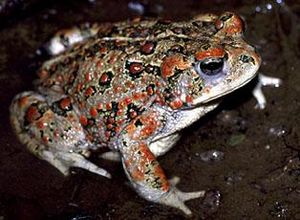Boreal toad facts for kids
Quick facts for kids Anaxyrus boreas boreas |
|
|---|---|
 |
|
| Scientific classification |
|
| Kingdom: | Animalia |
| Phylum: | Chordata |
| Class: | Amphibia |
| Order: | Anura |
| Family: | Bufonidae |
| Genus: | Anaxyrus |
| Species: | |
| Subspecies: |
A. b. boreas
|
| Trinomial name | |
| Anaxyrus boreas boreas (Baird and Girard, 1852)
|
|
The boreal toad (Anaxyrus boreas boreas) is a special type of western toad. Think of it like a specific kind of dog breed within a larger dog family. These toads mostly live in the Southern Rocky Mountains. Sadly, their numbers have been going down because of a sickness called chytrid fungus. This fungus is a big problem for many amphibians.
Because of this, the boreal toad is now listed as an endangered species in Colorado and New Mexico. This means they are at risk of disappearing forever. In Colorado, it's the only type of toad that lives high up in the mountains, in places called alpine areas.
Contents
What Does the Boreal Toad Look Like?
Boreal toads don't have a bony ridge on their head, which is called a cranial crest. You can tell them apart from other western toads by looking at their belly. It has many dark spots.
Adult male toads are usually about 2.4 to 3.1 inches long. Females are a bit bigger, from 2.9 to 3.9 inches long. Their skin can be brown or green. They also have a clear white stripe down the middle of their back.
Both male and female boreal toads have dry, bumpy skin. They also have two oval-shaped glands behind their eyes called parotoid glands. These glands can release a mild poison to protect them from predators. Male boreal toads do not have a vocal sac, so they don't make a loud mating call like some other frogs and toads.
Where Do Boreal Toads Live?
The boreal toad can be found in several places across North America. These include Wyoming, Colorado, Idaho, Washington, British Columbia, Alaska, Utah, and northern New Mexico.
They prefer to live in wet places that are high up in the mountains. These areas are usually between 8,000 and 12,000 feet above sea level. They like quiet, shallow water such as lakes, marshes, ponds, and bogs. These watery spots are very important for them to breed and lay their eggs.
What Do Boreal Toads Eat?
Boreal toads are not picky eaters. They enjoy a wide variety of insects and other small creatures without backbones. Their diet includes common bugs like grasshoppers, beetles, flies, and mosquitoes. They use their long, sticky tongues to catch their prey.
How Do Boreal Toads Reproduce?
The breeding season for boreal toads usually happens from May to late July. They choose marshes and still waters to lay their eggs. Female toads can lay a lot of eggs, usually between 3,000 and 8,000 at one time!
The eggs hatch into tadpoles, which are usually black. These tadpoles take about two months to grow and change into small toads. This process is called metamorphosis.
What Threats Do Boreal Toads Face?
One of the biggest dangers to boreal toads is the chytrid fungus. Its scientific name is Batrachochytrium dendrobatidis. This fungus causes a skin disease in many types of amphibians.
Scientists are still learning exactly how this fungus spreads. It harms amphibians by feeding on a protein in their skin called keratin. This causes their skin to thicken, a condition called keratosis. This thickening can make it hard for the toad to breathe through its skin. It also stops them from absorbing water and important salts from their environment. This can lead to serious health problems or even death.

